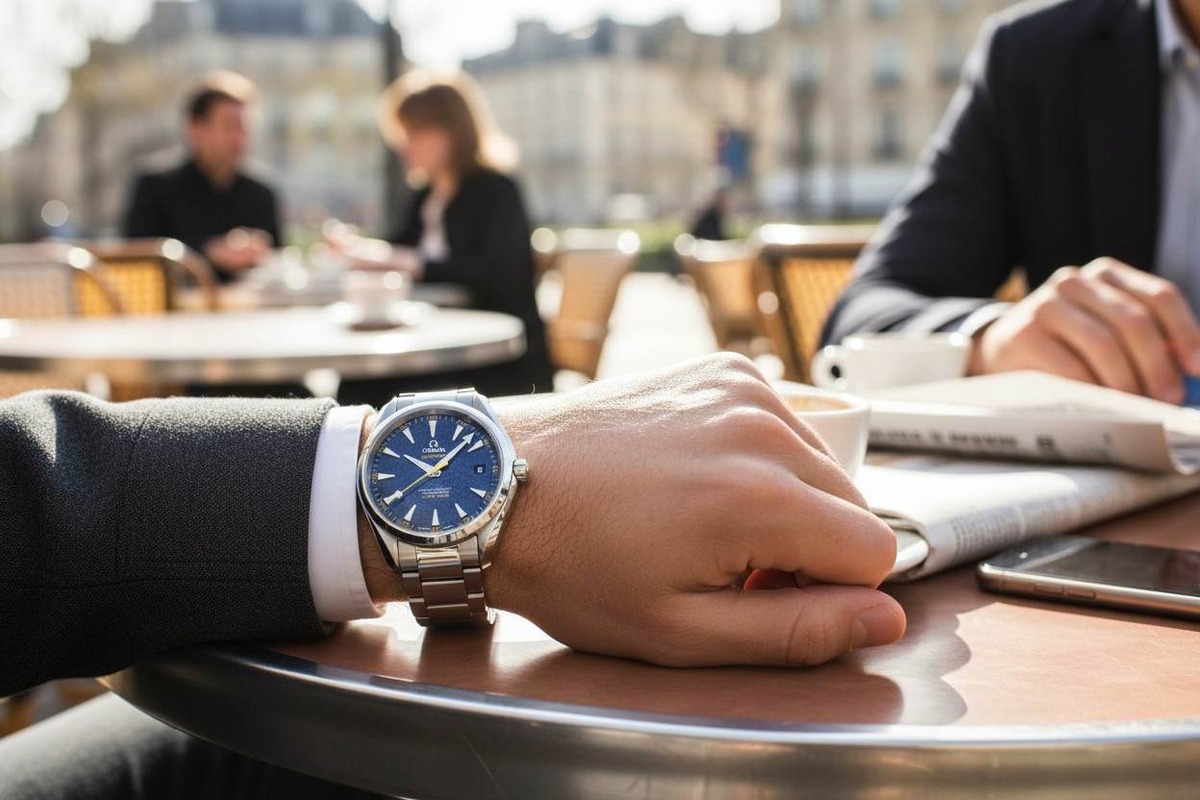Why is a watch worn on the left wrist? We explore the origins of this rule!
Why is a watch worn on the left wrist? This question returns regularly, especially when someone wears it differently than most people. Although it might seem like a matter of fashion or chance, there's specific history, comfort, and watchmaking logic behind this choice. Check what really lies behind this everyday habit – and whether it's still worth sticking to it today.
Not without reason on the left – learn the practical arguments that support this choice
Although the topic may seem trivial, choosing the left hand as the "default place" for a watch is not accidental. It's primarily related to everyday comfort. Most people in the world are right-handed, which means the left hand naturally performs fewer dynamic, intensive movements. Thanks to this, the watch gets knocked around less, catches on objects less frequently, and simply has fewer chances of accidental damage. Wearing it on the less active hand simply translates to longer lifespan – and this doesn't just concern the watch strap itself, but also the mechanism or crystal.
In everyday use, men's watches worn on the left hand work better when driving a car, typing on a keyboard, or even doing simple household chores. Many people also notice that it's easier to put a watch on the left hand because you use your right hand to fasten the strap – your dominant hand. As a result, the vast majority of models are designed with wearing them on the left side in mind. This applies to both classic analog watches and modern smartwatches. So if you're wondering whether this really matters – yes, it does and it's quite practical.
Tissot T-Classic T063.209.11.058.00 is an elegant Swiss Made women's watch with 31 mm diameter that captivates with minimalist black dial, Roman indices, and classic steel bracelet.
History of the wristwatch – how the army, aristocracy, and watchmakers shaped this habit
The watch as a styling element and utility tool has a really long history, and its place on the wrist was not chosen accidentally at all. Already in the 17th and 18th centuries, watches were considered luxury accessories – worn mainly by aristocracy and representatives of higher society. Back then they were more often attached to chains or straps and treated more as decoration than a practical tool. One of the oldest examples is a timepiece given to Elizabeth I. It was women who wore watches on their wrists earlier than men, which may be surprising considering how we perceive this accessory today.
Real change came in the 19th century, when military officers began using watches. Wearing a watch on the wrist – instead of in a pocket – allowed quick and efficient time checking without having to interrupt maneuvers. Especially during wartime, synchronization was crucial. Wristwatches gained recognition, and their mass production in the early 20th century only strengthened the trend that penetrated civilian everyday life. Today, although we no longer live in the era of world wars, the habit of wearing a watch on the left side is still going strong – and not without reason. Men's aviation watches, inspired by former military models, still constitute a fashionable and functional element of men's wardrobe today.
Roamer Aphrodite 600843 41 59 50 is a luxurious Swiss Made women's watch that enchants with a black mother-of-pearl dial, subtle zircons, and decorative stone in the lower part of the dial.
Watch on the left or right? Time to dispel myths and show that the choice can be yours
There's a belief that "that's just how it's done" – you wear a watch on the left and that's it. But in reality, there's no rule that says a watch must be on a specific hand. It's rather a habit that has become the norm over the years. Interestingly, for left-handed people, wearing a watch on the left hand can be uncomfortable because it interferes with writing or performing precise activities. That's why more and more people decide to wear a watch on the side that simply suits them better – and contrary to appearances, this is not breaking any "watch etiquette."
Many brands recognize these differences and introduce watches with the crown placed on the left side of the case to their offerings, designed with left-handed people in mind. These are so-called "lefty watches," which are more comfortable to put on and operate if your dominant hand is the left one. Regardless of whether you choose women's watches or men's watches, you have every right to wear them however is most comfortable for you. It's not a sign that you're doing something "wrong" – it's an expression of adapting the watch to you, not the other way around. So if you've always worn a watch on the left but something doesn't feel right – don't be afraid to check how it works on the right. Your comfort matters more than habits from a hundred years ago.
Casio Edifice Classic Chronograph EFR-526D-2AVUEF is a sporty-elegant watch with blue dial, chronograph function, and 100M water resistance, perfect for everyday wear and special occasions.
Right-handedness, crown, comfort – how functionality influenced everyday watch wearing
It's not just about fashion or rules – the layout of the watch and its elements was closely related to functionality from the beginning. When watchmakers began designing wrist models on a mass scale, they had to take into account that the vast majority of people are right-handed. For this reason, the crown – the element for setting time – began appearing on the right side of the case, making it easier to operate with the right hand when the watch was worn on the left. This layout was simply the most convenient and intuitive – and remains the standard in most models today. Interestingly, this functionality is still relevant, regardless of whether we're talking about classic hand-wound men's watches or more modern constructions.
Men's sports watches often have additional buttons (pushers) that are also designed for easy operation when worn on the left hand. The same applies to elegant women's watches, which despite their delicate design maintain a button layout consistent with the classic scheme. All so that it not only looks good, but is also maximally comfortable in everyday use. And it's precisely this comfort, resulting from thoughtful details, that made the left hand become the "default" place for a watch.
See popular articles

What was the first watch in space? Find out what astronauts wear on their wrists
Did you know that the first watch that flew into space wasn't on a human wrist, but... attached to a dog's leg? The history of timepieces in space is a fascinating story of technological rivalry, astronaut courage, and extraordinary precision that could save lives. From the Soviet Pobeda and Gagarin's Sturmanskie to the legendary Omega Speedmaster, which passed NASA's most brutal tests – each of these watches became part of space exploration history. Discover what astronauts actually wear on their wrists and why even today, in the smartwatch era, they still choose mechanical legends.

What is GMT time and how can you use this function on your watch?
Not every watch shows only one time – some can do much more. The GMT function allows you to track the time in two or even three time zones simultaneously, making it ideal for travellers, pilots and people working internationally. But before you learn how it works and what the GMT time zone actually is, it's worth learning about its history – from Greenwich, London, to modern watches with the most advanced mechanisms.

Dlaczego zmieniamy czas na zimowy w zegarkach? Tłumaczymy mechanizm i historię zmiany czasu
Dwa razy w roku cofamy lub przesuwamy wskazówki zegara, ale rzadko zastanawiasz się, po co właściwie jest zmiana czasu i dlaczego wciąż jej przestrzegamy. To nie tylko kwestia tradycji – za tym zwyczajem stoi historia, decyzje polityczne i próba lepszego wykorzystania światła dziennego. Sprawdź, jak działa mechanizm przestawienia czasu, skąd się wziął i jakie ma znaczenie dziś.

Zegarki solarne - ranking ciekawych modeli i wszystko co warto wiedzieć przed zakupem
Zegarki solarne to nowoczesne połączenie stylu i praktyczności – zasilane światłem, niezawodne i przyjazne środowisku. Dzięki wbudowanym panelom solarnym nie wymagają regularnej wymiany baterii, co czyni je wyjątkowo wygodnymi w codziennym użytkowaniu i bardziej ekologicznymi. W naszym rankingu znajdziesz modele, które wyróżniają się nie tylko atrakcyjnym designem, ale również bogatą funkcjonalnością i imponującą trwałością, idealne dla wymagających użytkowników poszukujących zegarka na lata.

Jak zmienić czas na zimowy w Casio G Shock?
Zmiana czasu potrafi zamieszać – nie tylko w głowie, ale i na nadgarstku. Jeśli nosisz G-Shocka i chcesz szybko przestawić go na czas zimowy, nie musisz zagłębiać się w instrukcje ani zgadywać, który przycisk za co odpowiada. W tym poradniku znajdziesz konkretne wskazówki, proste kroki i sprawdzone triki, które pomogą Ci bez nerwów ustawić zegarek Casio G-Shock – niezależnie od modelu, który masz.

Jak dobrać biżuterię do zegarka? Zasady, inspiracje i gotowe triki stylizacyjne
Dobranie biżuterii do zegarka to nie tylko kwestia gustu, ale przede wszystkim umiejętność stworzenia spójnej, stylowej całości. Zegarek może być subtelnym tłem dla dodatków albo główną ozdobą, wokół której budujesz cały look. Sprawdź, jak łączyć metale, wybierać bransoletki i tworzyć zestawienia, które zawsze wyglądają elegancko i nowocześnie.

Jaki zegarek na 40 urodziny wybrać? TOP 5 wyborów
Czterdzieste urodziny to wyjątkowy moment – symboliczny etap życia, w którym zegarek może stać się nie tylko praktycznym dodatkiem, ale także wyrazem stylu, statusu i osobowości. Zegarek na 40 urodziny powinien podkreślać dojrzały gust, elegancję oraz indywidualność obdarowanego – kluczowe znaczenie ma jakość, prestiż marki oraz funkcjonalność dopasowana do codziennych aktywności Poniżej przedstawiamy TOP 5 zegarków męskich na 40 urodziny dostępnych w ofercie sklepu WestWatches – zapraszamy!

Jaki zegarek kupić na dzień chłopaka? TOP 6 propozycji od West Watches
Dzień Chłopaka to świetna okazja, aby podarować coś wyjątkowego – prezent, który będzie nie tylko praktyczny, ale i symboliczny. Zegarek to zawsze trafiony wybór – elegancki, funkcjonalny i trwały. Ważne jednak, by dopasować go do stylu oraz trybu życia obdarowywanego. Czy woli klasyczną elegancję, sportowy look, a może nowoczesne technologie? Poniżej znajdziesz sześć propozycji z oferty WestWatches.pl, które sprawdzą się jako idealny prezent.

Czym jest bezel zegarka? Wyjaśniamy jego zastosowanie i zalety
Bezel to detal, który często umyka uwadze, a w rzeczywistości decyduje o funkcjonalności, stylu i bezpieczeństwie zegarka. To właśnie ten pierścień sprawia, że czasomierz staje się czymś więcej niż tylko ozdobą na nadgarstku. Dowiedz się, co to jest bezel w zegarku, jak działa i do czego możesz go wykorzystać na co dzień.











